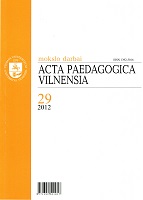MOKYKLOS KULTŪRA KAIP UGDOMASIS KONTEKSTAS IR KAIP PRIEVARTA
SCHOOL CULTURE ASACONTEXT AND ASAVIOLENCE
Author(s): Lilija DuoblienėSubject(s): Education
Published by: Vilniaus Universiteto Leidykla
Keywords: kultūra1; kūryba2; mokykla3; prievarta4;
Summary/Abstract: This paper deals with the features of school culture, emphasizing time and space as the most important conditions for understanding contemporary educational problems. The growing gap between the two contemporary generations (youth and their teachers, parents) de-pends on many different segments of nowadays’ society, the most important being the different perception of space and time by these generations, which in future may result in a different way of thinking and behaviour. This idea is implied by studying the cultural transmission in Lithuania (2010), the EUdocuments, the EUstatistics of cultural values and the ideas of critical theory and critical pedagogy. The analysis shows that the new school culture creates a new type of relationships between the teacher and the students and changes their roles. The teachers become cultural consumers while students tend to be more innovative and creative, to perceive their personal role as that of a creator. Such a transforma¬ tion of the relationship develops naturally in spite of school administrators’ efforts to ensure the old type of relationships and the growing school life control through rituals, teaching vocabulary and pedagogical code, described by Bernstein, McLaren, Foucault and others. The new way of learning depends on the new technologies helping a student “to be” at a huge distance and in different places in one moment, but this opportunity is not accounted for by school administrators and teachers. They limit this possibility through school structure, norms, standards, vocabulary, in other words, use the management of students’ time and space and thus increase students’ disappointment with school culture. Key words: culture, school, creativeness, violence
Journal: Acta Paedagogica Vilnensia
- Issue Year: 2012
- Issue No: 29
- Page Range: 9-21
- Page Count: 13
- Language: Lithuanian

